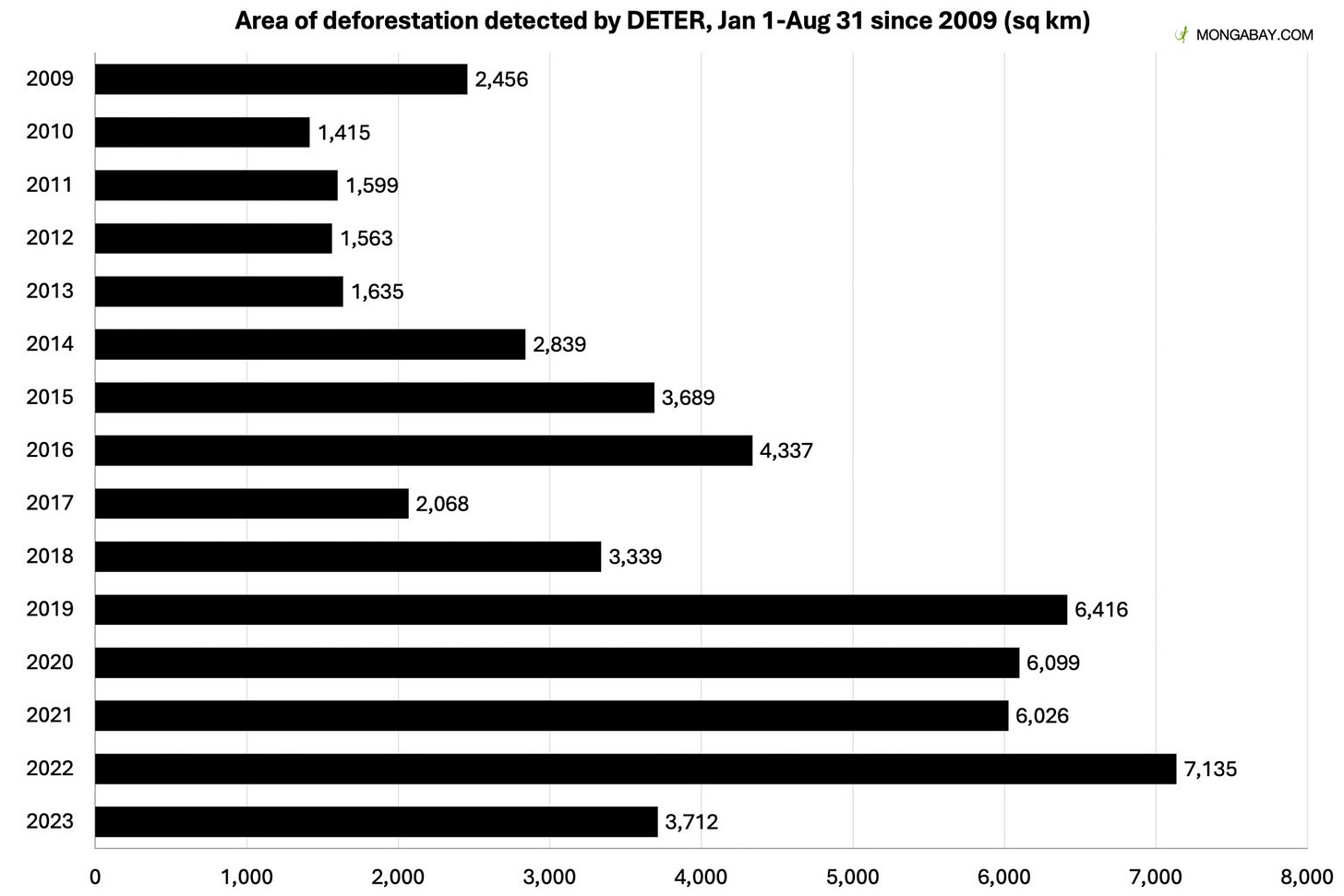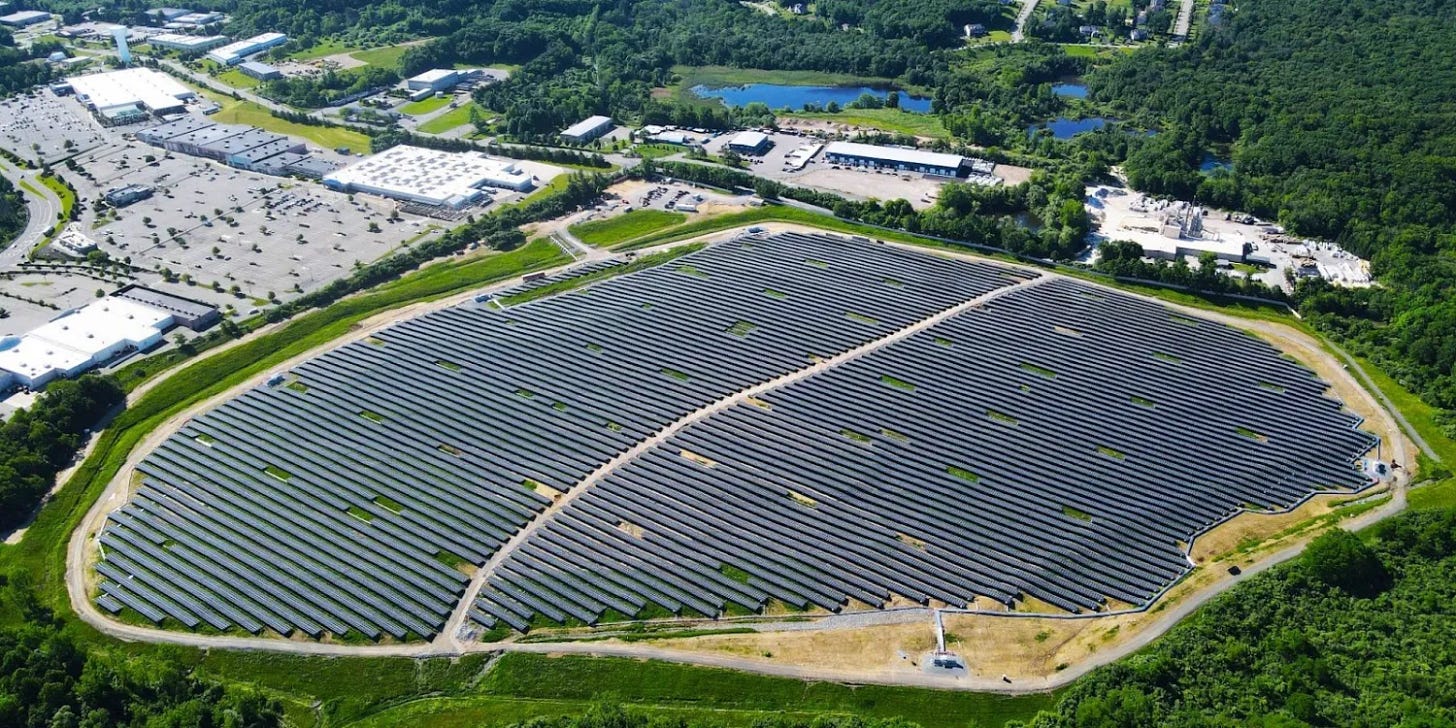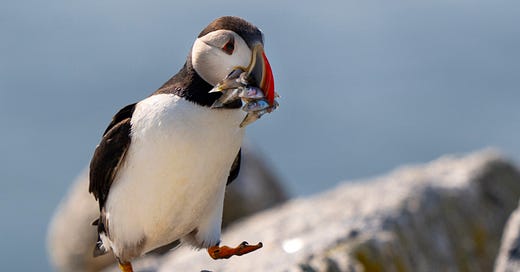The Weekly Anthropocene, September 13 2023
Deforestation continues to drop in Brazil, solar booms in America and South Africa, the "best possible outcome" for two thousand rhinos, and more!
Maine
The population of Atlantic puffins in Maine has had a lot of ups and downs in the Anthropocene so far. They were almost all killed off by hunters in the 1800s, with only one breeding pair left by 1901 and still only a few dozen breeding pairs by the 1970s. But when scientists started an active conservation program in 1973 and introduced a few new chicks from Newfoundland, the puffins thrived: there were more than 1,300 breeding pairs (at least 2,600 individuals) by 2021. However, they were imperiled anew when record heat waves and rainstorms led to a catastrophic nesting failure in summer 2021, with most chicks starving due to absent fish or freezing in soaking rain.
Now, the population is rebounding again despite ongoing climate disruptions, with a successful breeding year in 2023 as many of the puffins adapted to rapid shifts in ocean temperature and resultant unusual patterns in fish availability1. Maine’s puffin numbers appear to be stable or growing, with up to 3,000 birds.
This writer’s home state continues to serve as a fascinating microcosm for global conservation efforts!
Brazil

As this newsletter has previously highlighted, deforestation in the Brazilian Amazon has declined further and further since the inauguration of forest-defending President Lula da Silva in January 2023, replacing the actively pro-deforestation Jair Bolsonaro. The news just keeps getting (relatively) better: Brazil’s national satellite deforestation alert system reported that only 563 km2 of the Brazilian Amazon was cut down in August 2023, down 66% from August 2022. For January through August 2023, 3,712 km2 of Amazon rainforest were lost. That’s bad, but it’s better than before: a decrease of 48% from the 7,135 km2 lost in January-August 2022 and the lowest deforestation figure since 2018 (the last pre-Bolsonaro year). Enforcing environmental law is good!
United States

The American clean energy revolution just keeps on keeping on! Some recent highlights:
On August 31, 2023, the Department of Energy announced a $15.5 billion funding package to help American automakers transition to electric vehicles, retooling their factories and retraining their workers. Notably, some of the funding will prioritize EV projects with union jobs or unusually high-wage jobs, as part of the Biden Administration’s broader strategy to ensure a “just transition” for American workers.
On September 6, 2023, the Department of Energy announced a funding package of up to $150 million ($0.15 billion) to support domestic critical mineral supply chains, vital for America’s new and rapidly growing battery manufacturing sector.
The prospects for which seem brighter and brighter! A new analysis recently found that the McDermitt caldera, in the deserts on the Nevada-Oregon border, may be home to the world’s largest deposit of lithium (even bigger than the Bolivian deposit!), with an estimated 20 to 40 million tonnes of the vital battery mineral. For the sake of a cooler, safer world, we need to mine it ASAP! Companies are already proposing new, more sustainable methods tailored to the area.
On September 6, 2023, the Biden Administration canceled the remaining seven Trump-era oil and gas leases in the Arctic National Wildlife Refuge.
The U.S. Solar Energy Industries Association reports that the solar boom continues to outperform even optimistic forecasts, with 32 gigawatts (32,000 MW) of new solar capacity set to come online in 2023, up 52% from the 20.2 GW installed in 2022. And future solar panels will increasingly be made in America: nnouncements of domestic solar manufacturing projects continue to proliferate thanks to the Inflation Reduction Act!
The state of Hawaii closed its last coal plant one year ago in August 2022. The lights have stayed on, without a single resulting blackout, thanks in large part to a surge in rooftop solar and distributed battery storage!
South Africa (Rhinos)
For years, an offbeat entrepreneur accumulated a massive herd of 2,000 southern white rhinos2 (up to 15% of the entire species!) at his “Platinum” ranch in the North West province South Africa, hoping to sell vast amounts of (nonlethally trimmed, regrowable) rhino horn in the expectation that the rhino horn trade would soon be re-legalized. This didn’t happen, the owners lost money, and they put the rhinos up for auction in April 2023, initially receiving no bids. The prospect of the rhinos being sold off to unknown buyers (or poached if the failing ranch stopped funding its state-of-the-art security, which runs to over $425,000 per month) caused substantial concern in the conservation community. In September 2022, renowned NGO African Parks reached a deal to acquire the ranch and all the rhinos, announcing that they would fund continued security and support staff while developing a plan to rewild all the rhinos into well-secured parks across Africa over the next ten years.
This is probably the best possible outcome, for the rhinos and the world. African Parks is likely the single most reputable, successful, and organizationally robust conservation presence in Africa (or perhaps the world) at the moment, managing 22 national parks for 12 different African countries and routinely pulling off complex, large-scale translocation operations, once famously trucking five hundred elephants across Malawi. Very few institutions in the world could even handle two thousand rhinos, and even fewer could credibly plan to rewild them, but African Parks can. Great news!
South Africa (Solar)
As its increasingly dysfunctional coal-dependent national grid experiences rolling blackouts, South Africa is responding with an unprecedentedly fast solar boom, as citizens seek to ensure a reliable source of electricity. Rooftop solar capacity in South Africa has increased by an unbelievable 349% in just over a year, from 983 megawatts in March 2022 to 4,412 megawatts in June 2023. South Africa also imported five times as many batteries in Q1 2023 as in the entire year of 2022, as people look for reliable storage for their shiny new solar panels. At this rate, RMB Morgan Stanley projects that the increasingly solar-powered South African private sector may generate more electricity than the national grid by 2025!
And while its people work to make themselves energy independent, international aid is helping South Africa’s creaky grid start down the long road towards a better future. South Africa signed a Just Energy Transition Partnership (JETP) deal in 20213, in which France, Germany, the UK, the USA, and the EU together pledged to mobilize $8.5 billion in public and private financial support to help the country decarbonize. That’s now starting to pay off: the Komati coal plant in Mpumalanga province shut down in October 2022, and it’s being transformed into a renewable energy complex, with a planned 150 megawatts of solar, 70 MW of wind, and 150 MW of battery storage as well as retraining courses for ex-coal workers to gain skills useful for the renewable energy industry. There’s a long way to go, but a clean energy future for South Africa is starting to be born!
Not all seabirds are managing to survive the climate-turbulent oceans of the Anthropocene as well as Maine’s puffins (for example, emperor penguins in the Bellingshausen Sea region lost almost all of their chicks due to record-low sea ice in 2022), but this newsletter feels it’s important to highlight the reasons for hope. Animals want to survive: unlike ice that will just melt if it gets too hot, animals are autonomous agents capable of learning and changing their behavior to stay alive even when their ecosystems are severely disrupted. As a recent paper found, many species of seabird have managed to stage astonishing comebacks in the last few decades despite the extra challenge of climate change. If humans stop hunting, persecuting, and poisoning our wild brethren, and perhaps put in some work to help them access new resources and habitat, this writer suspects we’ll be pleasantly surprised by how many can make it.
If you heard something about white rhinos nearing extinction recently, it’s an understandable point of confusion. The southern white rhino (Ceratotherium simum simum) has rebounded from a low of 30-40 individuals in the 1940s to thousands today (probably somewhere between 10,000 and 20,000), but the northern white rhino (Ceratotherium simum cottoni) has only two individuals left, both females in captivity who are incapable of breeding in any case. There is still a chance for a future for the northern white rhino though: we have some saved DNA from multiple males, and several northern white rhino embryos have been created in a lab, with scientists hoping to reimplant them into a southern white rhino female sometime soon.






